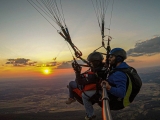
The foundation of a safe scuba dive is using good diving equipment. This is a practice where you can't cut corners on details, so it's best to be guided by those who know most about it, especially when it comes to diving regulators, as they're what allow us to breathe underwater.
While it's not always straightforward, particularly if you don't dive regularly, it's advisable to have your own regulator if only to avoid using the same mouthpiece as previous divers who rented the equipment from the school or centre where you'll be diving.
Therefore, whether you're buying your own diving gear or renting it, knowing about its components and stages is crucial for safe practice, allowing you to focus solely on enjoying yourself.
You'll learn all this in your diving course, not during a discovery dive. That's why we recommend here some of the best diving schools and internationally recognised certifications available in our country to learn to dive with all the necessary guarantees.

The diving course includes a section specifically focused on the operation and fitting of the diving suit and all its components. In the first stage, you'll learn to reduce the air pressure from the tank through a component that creates intermediate pressure. But to avoid confusion about where to connect the pressure gauges - LP for intermediate pressure and HP to maintain the tank pressure - the connection type varies.
This is where you'll learn there are two types of oxygen tank connections: DIN and International or Yoke. While both serve to regulate pressure, they have significant differences. We've summarised their main characteristics to help you choose which system to use for each dive.

- The DIN system has its first stage threaded into the tank valve, meaning it screws into the valve's core. This is why the DIN system comes with its own O-ring, similar to a screw.
- Having its own O-ring means it can be replaced whenever needed without changing anything else.
- With DIN method first stages, you'll screw the regulator directly into the tank.
- DIN is the safest pressure regulation method and most used by technical divers as it can handle tanks up to 300 bars. However, this doesn't mean it's the easiest to use.
- Once screwed in at the required pressure, it's practically impossible to move due to the circuit's pressure.

- The Yoke or INT is the regulator clamp that slides over the tank valve.
- It's much simpler to use, making it the most common in recreational diving where 200-bar tanks are standard.
- Safe and user-friendly, the Yoke fits directly onto the tank by simply tightening without threading.
- Tanks with the INT system come with pre-installed O-rings.

Initially, both are safe, but DIN might excel in some aspects over Yoke, as DIN withstands pressures of 232 ATM and 300 ATM (they differ in thread length) while Yoke only handles 232 ATM. But beware! To work at 300 ATM, both the valve and tank must be rated for that pressure.
Another important point is that DIN, lacking the valve tightening knob, is less likely to snag on nets, roots, kelp... or any elements encountered during the dive.
DIN also has the advantage of letting you control the O-ring's condition.
As you'll see, DIN stands out in some areas, but this doesn't mean Yoke is inferior - it's as safe in operation as DIN, as only the tank connection differs, not the first stage's functionality.











